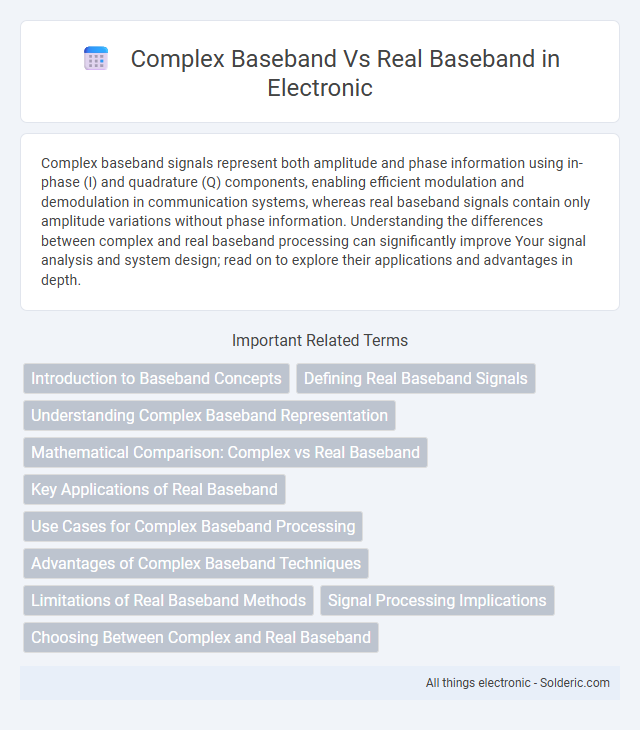Complex baseband signals represent both amplitude and phase information using in-phase (I) and quadrature (Q) components, enabling efficient modulation and demodulation in communication systems, whereas real baseband signals contain only amplitude variations without phase information. Understanding the differences between complex and real baseband processing can significantly improve Your signal analysis and system design; read on to explore their applications and advantages in depth.
Comparison Table
| Feature | Complex Baseband | Real Baseband |
|---|---|---|
| Signal Representation | Uses complex signals with in-phase (I) and quadrature (Q) components | Uses real-valued signals only |
| Bandwidth Efficiency | Requires half the bandwidth of real baseband for the same data rate | Requires full bandwidth equivalent to the signal bandwidth |
| Implementation Complexity | Higher due to processing of I/Q components | Lower complexity, simpler hardware |
| Common Applications | Modern wireless communications, OFDM, MIMO systems | Simple baseband processing, legacy systems |
| Frequency Translation | Direct complex downconversion and upconversion | Typically uses real mixing with additional filtering |
| Noise Performance | Better interference rejection with I/Q processing | More susceptible to image-frequency noise |
Introduction to Baseband Concepts
Baseband signals represent original information typically at low or zero carrier frequency, essential for digital communication systems. Complex baseband utilizes in-phase (I) and quadrature (Q) components to represent signals, enabling efficient modulation and demodulation of bandpass signals. Real baseband involves single-component signals, limiting its ability to accurately represent phase and frequency variations critical in modern communication technologies.
Defining Real Baseband Signals
Real baseband signals represent the original signal limited to a frequency range near zero Hertz, containing only real values without an imaginary component. They occupy a single-sided spectrum, meaning their frequency content exists solely on the positive frequency axis, unlike complex baseband signals which have both positive and negative frequency components. Understanding real baseband signals is essential for processing and demodulating communication signals that rely purely on amplitude and phase variations without quadrature components.
Understanding Complex Baseband Representation
Complex baseband representation uses both in-phase (I) and quadrature (Q) components to encode signals, allowing efficient modulation and demodulation in communication systems. This method simplifies frequency translation, enabling direct manipulation of signal phases and amplitudes in digital signal processing. Real baseband representation, by contrast, processes only a single signal component, limiting its ability to fully capture phase information and resulting in less efficient handling of modern modulation schemes.
Mathematical Comparison: Complex vs Real Baseband
Complex baseband representation uses both in-phase (I) and quadrature (Q) components, allowing signal processing in the complex domain, which captures amplitude and phase information more efficiently than real baseband. Real baseband contains only the in-phase component, requiring separate handling of phase information and typically doubling the bandwidth needed for equivalent signal representation. Your systems benefit from complex baseband models as they simplify modulation, demodulation, and filtering operations by leveraging complex arithmetic and reducing spectral requirements compared to real baseband signals.
Key Applications of Real Baseband
Real baseband processing is essential in applications such as analog signal demodulation, radar pulse detection, and audio signal processing, where the signals are inherently real-valued. It serves crucial roles in embedded systems and low-power IoT devices due to its simpler hardware requirements and reduced computational complexity compared to complex baseband. Real baseband algorithms are widely used in AM radio receivers and baseband filtering tasks where phase information is less critical.
Use Cases for Complex Baseband Processing
Complex baseband processing enables advanced wireless communication systems such as 4G LTE and 5G NR by facilitating efficient modulation schemes like QAM and OFDM. It supports MIMO antenna configurations and beamforming techniques critical for high data rate and multiuser environments. Complex baseband's I/Q signal representation allows precise channel estimation and adaptive equalization, enhancing overall signal quality and system performance.
Advantages of Complex Baseband Techniques
Complex baseband techniques enable efficient representation and processing of bandpass signals by utilizing both in-phase (I) and quadrature (Q) components, which enhances spectral efficiency and reduces hardware complexity. These methods facilitate advanced modulation schemes such as QAM and OFDM, improving data throughput and signal robustness in wireless communication systems. The ability to perform complex signal processing algorithms in the digital domain allows for better interference mitigation, channel estimation, and adaptive filtering compared to real baseband approaches.
Limitations of Real Baseband Methods
Real baseband methods are limited by their inability to efficiently represent and process signals with both magnitude and phase information, which can result in reduced performance in modern communication systems. These methods often suffer from bandwidth expansion and higher susceptibility to noise compared to complex baseband approaches. Your system's signal processing capabilities improve significantly when adopting complex baseband representation, allowing for more accurate modulation, demodulation, and filtering.
Signal Processing Implications
Complex baseband processing enables simultaneous manipulation of in-phase (I) and quadrature (Q) components, allowing efficient representation and filtering of bandpass signals at lower sampling rates and reduced computational complexity. Real baseband processing handles only a single real-valued signal, often requiring higher sampling rates and more processing resources to achieve equivalent spectral analysis and modulation. Your choice between complex and real baseband significantly impacts system design, influencing algorithm complexity, hardware requirements, and overall signal fidelity.
Choosing Between Complex and Real Baseband
Choosing between complex baseband and real baseband depends on the modulation scheme and system requirements. Complex baseband processing offers advantages in handling quadrature amplitude modulation (QAM) and orthogonal frequency-division multiplexing (OFDM) by representing signals using in-phase (I) and quadrature (Q) components, enabling efficient frequency translation and demodulation. Real baseband is simpler and requires less computational resources, making it suitable for simpler modulation formats but limits flexibility for advanced signal processing and multi-carrier systems.
complex baseband vs real baseband Infographic

 solderic.com
solderic.com